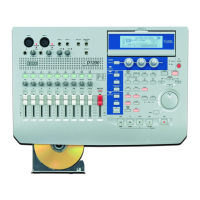Quick Start Tutorial
19
Step 1: Quick recordingStep 2: OverdubbingStep 3. Mixing
Step 4. Mastering
Select the “ ” button and press the [ENTER] key to open the dialog
box.
Select the “PreFaderLev” radio button, press the [ENTER] key, and
then press the [YES/OK] key.
3 As you play your guitar, watch the Ch1 and Ch2 meters and adjust
the INPUT 1 [TRIM] knob. You will not be hearing the guitar signal
at this point.
Adjust the level as high as possible without allowing the level
meter’s “CLP” indicator to light when you play most strongly.
In general, you should adjust the [TRIM] knob so that the peak indi-
cator (the LED near the [TRIM] knob) lights when you play your
loudest passage.
4 Now, let’s listen to the audio signal.
Set the [CHANNEL 1] and [CHANNEL 2] faders to unity gain (0 dB).
Access the [INPUT/OUTPUT/SOLO] “Monitor” tab page.
Select the “MasterLR” button and press the [ENTER] key to turn it
“On” (highlighted). Slowly raise the [MASTER] fader, and make sure
that you hear the sound of your guitar from the headphones.
5 Dial up your settings for the modeling effects.
Return to the Modeling mode page either by pressing the [MODE-
LING] key.
While you listen to the sound in your headphones or monitors, use
the three modeling knobs to adjust the “DRIVE,” “TONE,” and
“CABINET” settings to obtain the desired sound.
Use the [PHONES LEVEL]
knob or the [MONITOR OUT
LEVEL] knob to adjust the
output volume.
To allow a stereo effect to be
heard in stereo, turn the
[PAN1] knob to the far left
and the [PAN2] knob to the
far right.
To tune your guitar (→p.36:
Using the tuner)
Step 1: Quick recording

